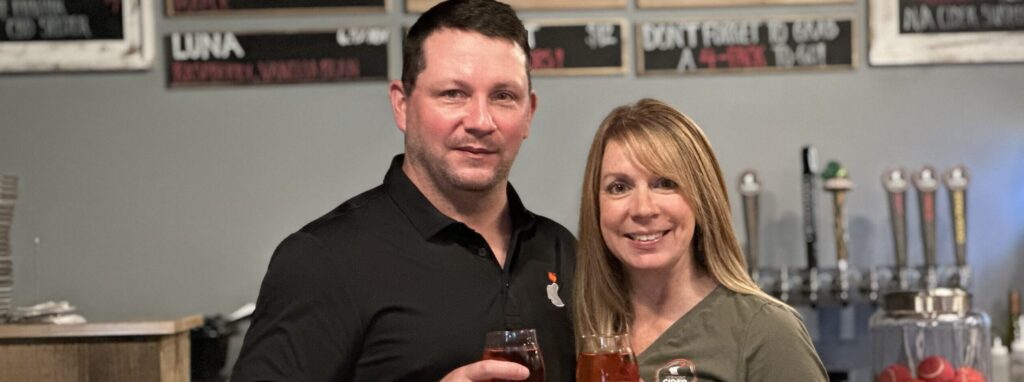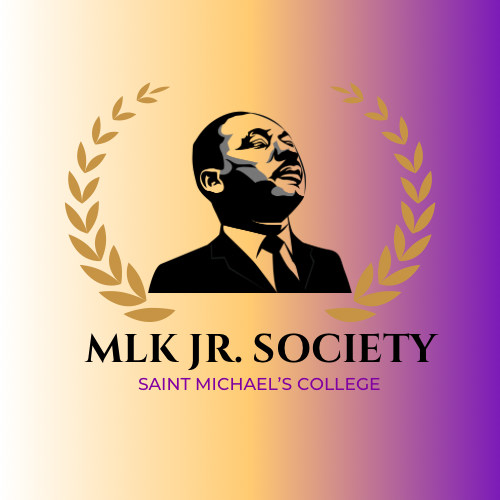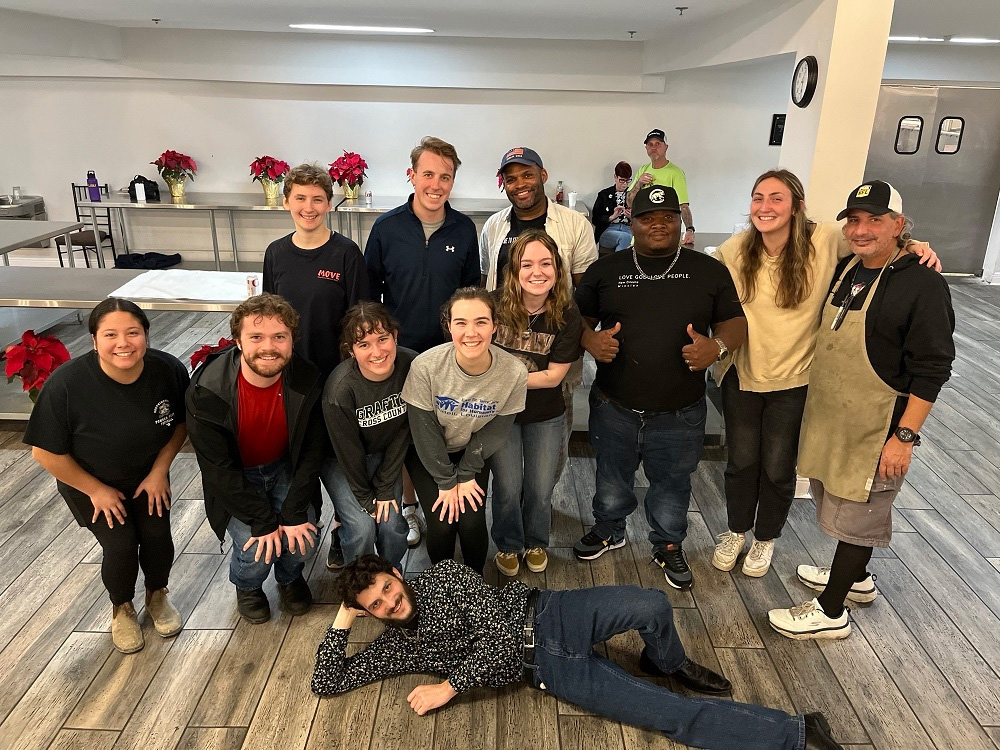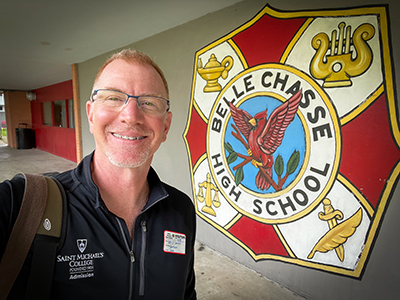All corners of campus join racism converation
All corners of campus join book-inspired racism discussion

Above, President Sterritt with Griffith and Lorrie Smith prior to the meeting; below, images of other groups in discussion. (Photos by Mark Tarnacki)
A 1963 meeting between Robert Kennedy and the eminent African-American writer James Baldwin brought leading black-activist voices of that era to the White House “to explain the rage that threatened to engulf black America,” according to a publishers’ website summary of Michael Eric Dyson’s challenging and, many say, prophetic book What Truth Sounds Like.
The book has been a centerpiece of a two-part campus conversation about racism this academic year initiated by President Lorraine Sterritt with wide support and participation from faculty and staff. More than 30 turned out Tuesday evening in the Dion Family Student Center Roy Room for the second of two planned book discussions. They sat in a large circle to start, then broke into seven four-person discussion groups to ponder racial, societal and campus questions for about half an hour before reporting back. Edmundites joined professors and staff from a wide cross-section of offices, alongside President Sterritt and her husband, classics instructor Bert Lain, for the event.
Tuesday’s campus conversation might have had this in common with the 1963 RFK meeting that Dyson’s book describes: each (on its own scale) was a purposeful assembling of informed community voices, urgently compelled by conscience to challenge wrong, harmful and deeply entrenched assumptions about race and the experience of African-Americans in America, even at the risk of causing discomfort, as the original meeting did for RFK, and as some of Tuesday’s questions might have caused for present-day Saint Michael’s people.
Professor Lorrie Smith of the English faculty suggested in her conversation-starting introductory remarks that many of the same issues and well-justified rage over inequities from 1963 persist, sadly, creating the need for such voices to speak today as much as in those times.
Now as then,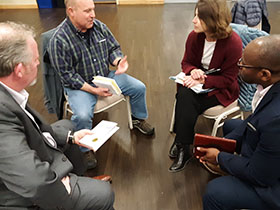 she suggested, each group in the conversation is vital “to continue our unfinished conversation. We are in dire need of more talk, more insight …. Everything useful then can be used now.” Smith’s specialty is African-American literature and culture, and she opened the meeting by setting the context that made 1963 such a “watershed year” in race relations: in early 1962 Baldwin published impactful and widely read essays in The New Yorker, a largely “white” publication; in April, Dr. Martin Luther King Jr. wrote his Letter from Birmingham Jail; the Birmingham church bombing killing four little black girls was in September; and August was the famous March on Washington with King’s “I Have a Dream” speech.
she suggested, each group in the conversation is vital “to continue our unfinished conversation. We are in dire need of more talk, more insight …. Everything useful then can be used now.” Smith’s specialty is African-American literature and culture, and she opened the meeting by setting the context that made 1963 such a “watershed year” in race relations: in early 1962 Baldwin published impactful and widely read essays in The New Yorker, a largely “white” publication; in April, Dr. Martin Luther King Jr. wrote his Letter from Birmingham Jail; the Birmingham church bombing killing four little black girls was in September; and August was the famous March on Washington with King’s “I Have a Dream” speech.
She described Dyson as “a leading public intellectual and also a preacher, professor and scholar” from our times — a Baptist minister who writes “in the tradition of prophetic writing in a powerful voice like the Prophet Jeremiah.” Before the breakout groups, Smith played audio of Dyson speaking some of his book’s most provocative and powerful words, driving home her point. His message on the audio built on the theme of the fictional African nation Wakanda that is depicted in the recent superhero movie Black Panther.
“Everything about Black Panther is timely and prophetic,” Dyson’s recorded voice proclaims on the recording in lyrical and passionate preachers’ cadences, adding, “its appeal is also its shame” since it’s sad that we must resort to fiction to find “a place where race is not an issue and blackness is taken from granted …” and where great blacks are honored and esteemed. “We love Wakanda because Wakanda loves us,” he said from the recording. “…Wherever it exits, exists too, infinite possibility …” and being in Wakanda for blacks is an experience “like white folks get every day of their life” except in the real world rather than in fiction, he said, continuing, “wherever whiteness exists and is seen as normal and presumed…fantasy ain’t needed when reality provides what fiction aims for … Wakanda matters because black lives don’t,” he said.
After all heard the recording, Smith referenced W.E.B. Dubois from 1903 asking a question about how it feels to be “a problem” — as in “the negro problem” commonly referenced in his time; by extension, she challenged the Saint Michael’s group to ask, “how does it feel today for white people to be ‘the problem’ instead — which seems to be the difficult consensus that these discussions have inexorably move toward, hard as that might be for some to embrace. She challenged the break-out groups to ask “where do you find yourself in relationship to Wakanda?”
The groups included: President Sterritt with Liz Inness-Brown of the English faculty, Claudine Bedell of the Education faculty, and Dawn Ellinwood of Student Life; Bert Lain, Mike Stefanowicz, Bethany Dietrich of the library and Barbara O’Donovan of Mathematics; Helen Donahey of the President’s Office, Frs. David Cray and Marcel Rainville of the Edmundites and Traci Griffith of journalism; Doug Babcock of Public Safety, Patrick Standen of Philosophy, Amy Saks-Pavese of Education and Kathy Butts of the counseling center; Fr. David Theroux of the Edmundites (Center for Peace and Justice), men’s basketball Head Coach Josh Myer, Robin Rhodes-Astor of Admission and Zsu Kadas of Mathematics; Tom VanDzura of Business, Ingrid Peterson of Career Counseling, Katie Kirby of Philosophy and Smith of English; and Heidi St. Peter of Academic Support, Pat Gallivan of the President’s Office, Moise St. Louis of the Multicultural Affairs Office and Doug Facey of Biology.
The conversations were earnest and thoughtful, with all members engaged and gesturing with animation for about half hour. Shortly after 8 p.m., Smith called them back to the big circle to share one or more “big idea” from each group discussion.
Doug Babcock said an idea his group came to right at the end is “the difference between changing policy and changing hearts” – that if society had started with changing hearts instead of policies as a solution to racial divides, we might be farther along. President Sterritt said her group concluded that white people and their prevailing attitudes and behaviors throughout society are the problem, “and we all agreed that our society is not moving forward on these issues at this time, and may in fact be moving backward, which is a tragedy.”
Fr. Cray told about his studies years ago along with Fr. Theroux at the New Orleans Xavier Institute for Black Studies formed by the American Black Catholic Congress, but, he said, the mindset of being white “missionaries” trying “to bring all our solutions for poor people who need them” is flawed from the outset since everyone benefits from one another in such interactions – it’s not a one-way street. Dawn Ellinwood said her group talked “about being able to listen and changing peoples’ hearts” too, and about how white people might learn “to truly listen and try to understand.”
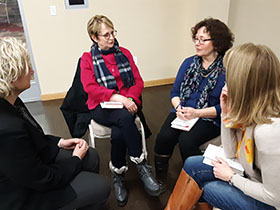 Barbara O’Donovan said her group spoke of societal systems such as for-profit prisons or rent-a-centers that prey on people, often poor minorities, to make money off of their dire situations or lack of education – specific instances of white people being the problem. “We came to the conclusion that education is really something that’s valuable and needs to be invested in,” she said – particularly curriculums that spread diversity across the spectrum.
Barbara O’Donovan said her group spoke of societal systems such as for-profit prisons or rent-a-centers that prey on people, often poor minorities, to make money off of their dire situations or lack of education – specific instances of white people being the problem. “We came to the conclusion that education is really something that’s valuable and needs to be invested in,” she said – particularly curriculums that spread diversity across the spectrum.
Traci Griffith told of an article that Moise St. Louis had sent her last week about creating syllabi for college classes that make sure more voices are represented in books and speakers in class. Zsu Kadas spoke of white people’s “desire to always fix things – we have trouble just listening and being with something and trying to understand,” even though it is correct to work on injustices through actions too. Heidi St. Peter said her group discussed “the importance of white people gathering and talking – we want to witness, but there’s not a lot of people of color here at Saint Michael’s, and it’s not their responsibility to do that — it’s our responsibility to do this.”
Griffith also spoke about “the problems associated with understanding how other people exist in the world” – that if you don’t have any experience it can be hard trying to see things through an student’s eyes, somebody who maybe “has never had a black teacher or Asian coach … so they don’t’ have any interactions with people who are not like them” – particularly where typical Saint Michael’s students come from.
St. Peter said that for MOVE service volunteers from Campus Ministry, it is “important to get out and be that witness.” Griffith said she took her young son to Selma on a service trip recently and plans to return this year, for example. Moise St. Louis said his group talked about the necessity for white reflection –noting “often the gaze is outward and not inward.”
Fr. Cray recalled when choirs from St. Peter Claver Parish in New Orleans, once run by Edmundites, would visit Saint Michael’s annually and what a rich exchange that was – St. Mike’s choral groups also went to New Orleans and stayed with hosts from the different culture, and it was really more about the human interactions than the music as such.
Babcock made a strong point when he said how he or other white people might have one or two interactions a day with African Americans or Asians or Latinos on campus and say, “well, that went OK, I guess everything must be OK” — but minority students will have “hundreds of those encounters for a day” on which to base their view, “so their perception won’t be the same as ours.”
President Sterritt spoke about slavery and reparations and how her group felt reparations are necessary due to the economic disparities that exist to this day limiting access to economic opportunities because of history.
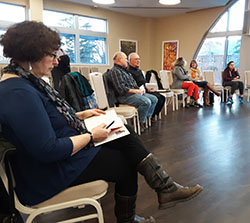 Griffith asked the group, “What are you telling the white people who weren’t here about the book and discussion?” Smith said she was hearing that perhaps a continuing of this discussion was advisable and favored by the group, and Fr. Cray said maybe each person present could make sure to invite three more from campus next time. A website for readings can be created by Durick Library staff.
Griffith asked the group, “What are you telling the white people who weren’t here about the book and discussion?” Smith said she was hearing that perhaps a continuing of this discussion was advisable and favored by the group, and Fr. Cray said maybe each person present could make sure to invite three more from campus next time. A website for readings can be created by Durick Library staff.
Katie Kirby said the author’s points on Wikanda were “a call to everyone to have passion for the beauty of black art and literature and idea – I heard that call directly to me.”
Patrick Gallivan said “we all have a way to make an impact here because of who we are and where we come from” with multiple ways “to figure out where we fit in an institution and how that plays out in the days ahead.”
Cathy Butts described a reading group in the Wellness Center that discusses such issues together regularly, saying that might be a good idea for other offices and departments.
Fr. Cray, Edmundite Superior General, offered some closing remarks. From his many years working, living and studying among the black community in the South and as a student being graded by black professors, he said, “you learn that white folks have so much to learn and it will never end for us to need to learn it.” He said instead of the commonly conjured “melting pot” image of American society as a way to think of diversity, he preferred a model of the Holy Trinity in the Edmundite and Saint Michael’s Catholic traditions — a model about “celebrating differences, but respectfully touching and greeting one another — unity in diversity is fundamental to Christian faith.”
Words from the publisher’s website of What Truth Sounds Like tied the ideas from Tuesday’s discussion well, noting the book “exists at the tense intersection of the conflict between politics and prophecy – of whether we embrace political resolution or moral redemption to fix our fractured racial landscape. The future of race and democracy hang in the balance.”
